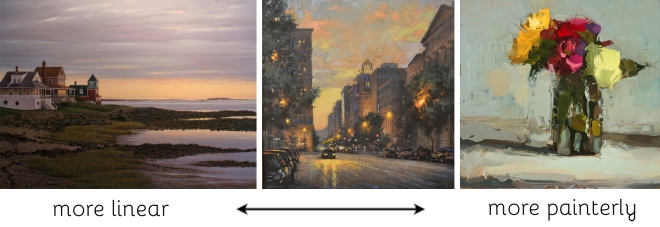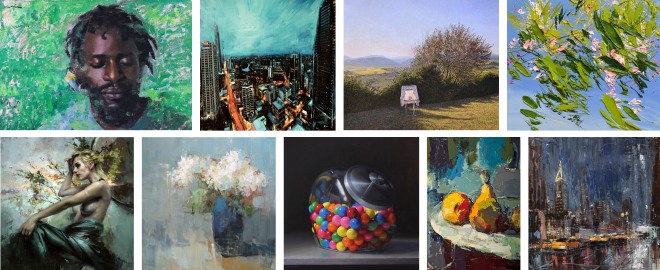Realism….Hyperrealism….Trompe l’oeil….There are many terms we use in the art world to describe the style in which something is painted, and even for those of us who work in the field, it can get a little confusing at times. The nuances of these styles and movements can be very subtle, but today we’ll just cover the basics. As we are preparing for the opening of the 10th Annual Juried Exhibition for the International Guild of Realism (August 28th!), I figured it would be appropriate to go over just what we mean by all those terms when we talk about Realism! Think of today’s post as a little visual glossary.
Objective vs. Non-Objective
First of all: for the sake of this post, and because it’s what we here at Principle Gallery represent, let’s assume all the art we discuss here is objective art. This essentially means that the art is meant to portray something. Non-objective art is different, as it is not “of” anything, but simply uses the elements and principles of design to create a visually stimulating image. Here are some notable examples of non-objective art:

So, now to look at objective art. A variety of terms are used to help describe and understand the way that an artist communicates the subject matter of an objective artwork. Let’s start with one of the most basic.
Abstract vs. Realistic
The word “abstract” is used a lot in the art world– so much so that its meaning had become a bit obscured. It is often (incorrectly) used interchangeably with “non-objective,” though the two do have different meanings. In fact, both objective and non-objective art can be described as “abstract,” as the word simply indicates a degree of separation from reality. Strict realism is the true opposite of abstract art, but abstract art can still certainly be representative of a person, place, or thing. In such cases, the reality-based subject is still being portrayed, but the realistic qualities have been abstracted for the purpose of the work.

Realism vs. Idealism
“Realism” is a term often used to describe an art movement from the 19th century, when artists– tired of the tradition of Romanticism/Idealism and inspired by the rise of the technology of photography– sought to paint things the way they really were. Romanticism, Neoclassicism, and Idealism were some of the predominant and “flowery” trends in European art for many centuries. These styles often involved adjusting the real appearance of the subject to be more aesthetically or ideologically pleasing (like painting a flower as perfect and flawless, even if the real flower has some wilted petals), exaggerating the emotions displayed by the people being painted, and celebrating lofty subjects like history, literature, mythology, and symbolism. Proponents of Realism, on the other hand, wanted to paint things as they really were, with no artificiality, exotic, or supernatural elements included, just all the real and dirty details. This also meant an emphasis on portraying the subject realistically with the brushstrokes, usually in what is called a linear fashion.
Linear vs. Painterly
The original Realists were rather straightforward about the way that they painted their subjects: crisp, sharp, and very much as they appeared to the human eye–this is all descriptive of linear painting. As the 18th century advanced, art saw the rise of Impressionism, and therefore a more “painterly” way of painting. Painterliness refers to a style in which artists portray something with less than perfect control. Not all edges must be clean and sharp, not every detail and nuance must be shown. This gentle, looser, and more expressive manner of painting was adopted by many masters of the 19th and 20th century, including Vincent Van Gogh, Pierre-Auguste Renoir, and John Singer Sargent.

Impressionism
Impressionism is a term that was originally coined to describe the art movement of the mid 19th century, pioneered by French artists like Claude Monet, Pierre-Auguste Renoir, and Edouard Manet. Over time, however, it has become a term more broadly applied to art of various time periods, and it describes a painterly style in which the traditional rules of academic painting are not necessarily followed, but rather freely applied color and light is emphasized over line, contour, and shading.
Photorealism vs. Hyperrealism
Photorealism is a US art movement that rose during the 1960’s and 1970’s in the wake of many non-objective art trends including Minimalism and Abstract Expressionism. The purpose of the movement was to reproduce photographs as closely as possible in another medium (like paint), down to the tiniest detail. During the course of the 20th century, the popularity of strict Photorealism faded a bit, eventually developing into what is known as Hyperrealism.
Hyperrealism is a kind of step forward from Photorealism. It does not involve the literal copy of a photograph, but rather utilizes the notions of precision and high definition and produces an image that can include emotional, social, cultural and political thematic elements to enhance the visual narrative. Think of it as painting that’s as realistic looking as a photograph without actually having to be based on a photograph! It gives the artist a little more freedom of expression this way. Hyperrealist paintings are always linear rather than painterly.

Trompe l’oeil
Trompe l’oeil is a French term meaning “deceive the eye,” and refers to art that is not only painted precisely and realistically, but contains some component of optical illusion that what is depicted is actually three dimensional. Master painters for many, many centuries have utilized tricks to give the illusion of depth and dimension in their works, but trompe l’oeil painters take it to the extremes with incredible depth and realism that makes you feel as though you could reach your hand into the painting! Be sure to keep an eye out for next week’s in-depth look at trompe l’oeil painting!
Contemporary Realism
The prevalent trend in objective art today is best categorized under the umbrella term of “Contemporary Realism.” Contemporary Realist approach representational or objective work and represent the modern age, but do so in a variety of ways. You can see by looking at the range of artists that we have here at Principle Gallery that while these artists are all painting contemporary subjects, some approach it with impressive precision and refinement, while others may render things in a more loose and painterly style. “Realism” today can incorporate an array of subject matters, styles of brushwork, and levels of true-to-life appearance. Take a look at the Principle Gallery paintings featured in this collage, and see if you can decide the most appropriate style terminology to apply to them:

It is a real joy for us at Principle Gallery to see the exciting and original ways that artists depict the world around them, both by incorporating methods from the past as well as infusing the work with a fresh, modern perspective. We are also thrilled to be able to host the 10th Annual Juried Exhibition for the wonderful International Guild of Realism. The show officially opens August 28th, and will contain 91 paintings and drawings from 82 talented Contemporary Realist artists. Be sure to visit our website and follow our social media pages on Facebook, Twitter, Instagram, Pinterest, and YouTube to stay up to date on all the news about the exhibition!


Great post!
Thank you very much, Krystal!
Wonderful post! Thank you so much for the whole series.
Thank you so much for following, Stuart!
Very interesting!
Thanks for the feedback!
Thank you for this enlightening article. As a realism painter with no formal education in the field, I truly appreciate the insights. And as I move in ever wider art circles, I am called upon to define my work more accurately. I found this timely and exceedingly helpful! I have already shared it with two of my local artist groups. Tomorrow, it will be shared in my weekly Studio News (newsletter). Thank you!!!